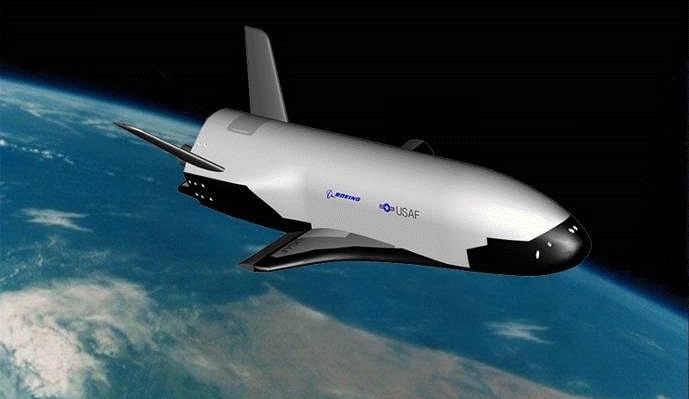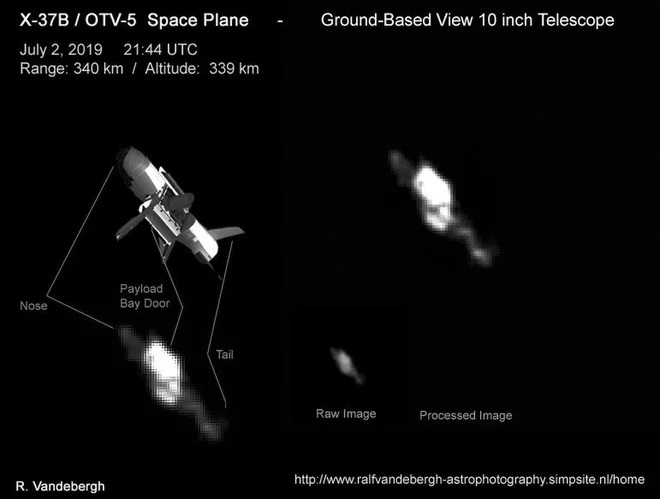Ever since it started taking to space, there has been a lot of mystery and controversy surrounding the USAF’s X-37B space plane. Despite the fact that this militarized-version of NASA’s orbital vehicle has conducted several spaceflights since its first in 2010, we still have no idea what its true purpose is. But so far, the smart money appears to be on it being an advanced spy plane.
Hoping to gather clues to this question, skywatcher and satellite tracker Ralf Vandebergh of the Netherlands has spent the past few months hunting for this space plane in the night sky. Recently, he was fortunate enough to not only locate the elusive X-37B in the sky but also managed to snap some photographs of it. Given its diminutive size and secretive-nature, this was no small feat!
Vandebergh first located the space plane back in May after several months of attempting to track it down. However, his attempts to photograph it were initially thwarted since the space plane did not appear to be following a predictable orbital pattern. But with a little help from the amateur astronomer community, he managed to reacquire it a little over a week ago.

As he conveyed in a recent interview with Live Science:
“When I tried to observe it again [in] mid-June, it didn’t meet the predicted time and path. It turned out to have maneuvered to another orbit. Thanks to the amateur satellite observers’ network, it was rapidly found in orbit again, and I was able to take some images on June 30 and July 2.”
People will recognize the X-37B – aka. the Orbital Test Vehicle (OTV) – because of its resemblance to the retired NASA Space Shuttle. This is no coincidence since this space plane was also developed by Boeing, one of the main contractors on the orbiter element of the Space Shuttle. And much like its predecessor, the X-37B is designed to test reusable technology, is sent into space using a launch vehicle and returns to Earth under its own power.
Unlike its predecessor, the X-37B is very small, measuring just 8.92 m (29 ft) in length and 4.55 m (14 ft 11) from one wingtip to the other. In contrast, the orbiter element of the Space Shuttle measures 56.1 m (184 ft 1 in) in length and 8.7 m (28 ft 7 in) in diameter. This makes the X-37B the smallest space plane ever built. As
“It is really a small object, even at only 300 kilometers [186 miles] altitude, so don’t expect the detail level of ground-based images of the real space shuttle… We can recognize a bit of the nose, payload bay and tail of this mini-shuttle, with even a sign of some smaller detail.”

Nevertheless, Vandebergh managed to track the spacecraft manually using his 6×30 finderscope. He then photographed the space plane using his 10-inch F/4,8 aperture Newtonian telescope and an Astrolumina ALccd 5L-11 mono CMOS camera. With the help of some processing, the image shows the X-37B with its payload doors open.
This latest flight (OTV-5) constitutes the fifth flight for the spacecraft, which has now spent a total of more than 666 days in space. OTV-5 began on Sept. 7th, 2017, when the spacecraft was launched atop a SpaceX Falcon 9 from NASA’s Kennedy Space Center (KSC) in Florida. This launch took place in spite of the fact that Hurricane Irma was threatening the peninsula at the time.
As to what the X-37B is doing on this latest mission, and when it will end, those items remain classified. But given that the spacecraft is officially-billed as a technology demonstrator and test vehicle, it is possible that this is what it has been doing all this time. Perhaps the tests are gathering information for the creation of a next-generation aerospace fighter, something that would go into the creation of a “space force” someday!
Regardless, this act of orbital sleuthing is a testament to the capabilities of citizen scientists and the role they play in modern astronomy. Thanks to sophisticated instruments, the availability of online resources, and the data-sharing that is possible today, amateurs and volunteers are able to make a significant contribution and do the things that observatories and research institutions cannot.
Further Reading: Live Science

